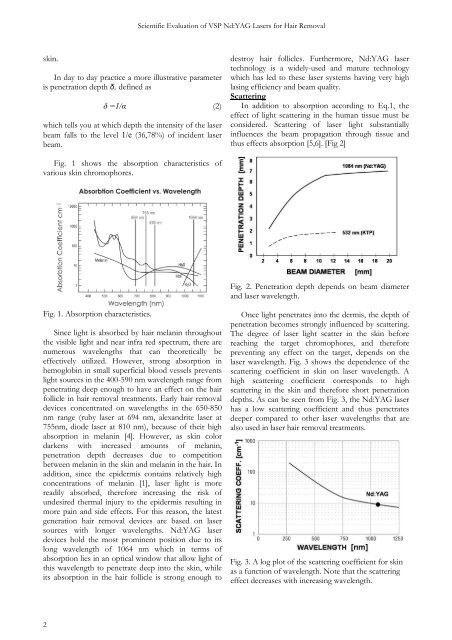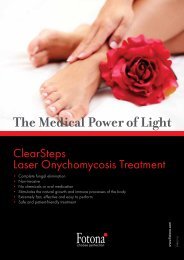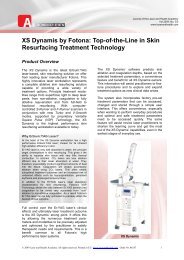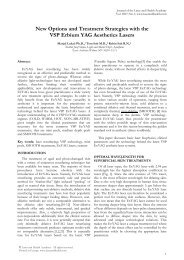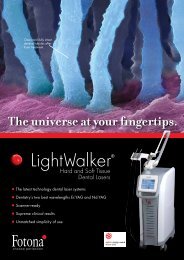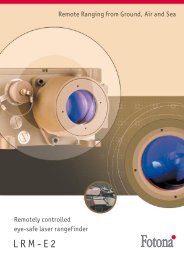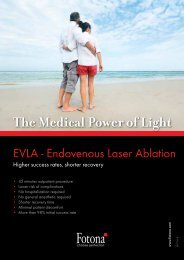Scientific Evaluation of VSP Nd:YAG Lasers for Hair Removal - Fotona
Scientific Evaluation of VSP Nd:YAG Lasers for Hair Removal - Fotona
Scientific Evaluation of VSP Nd:YAG Lasers for Hair Removal - Fotona
Create successful ePaper yourself
Turn your PDF publications into a flip-book with our unique Google optimized e-Paper software.
<strong>Scientific</strong> <strong>Evaluation</strong> <strong>of</strong> <strong>VSP</strong> <strong>Nd</strong>:<strong>YAG</strong> <strong>Lasers</strong> <strong>for</strong> <strong>Hair</strong> <strong>Removal</strong><br />
skin.<br />
In day to day practice a more illustrative parameter<br />
is penetration depth δ, defined as<br />
δ =1/α (2)<br />
which tells you at which depth the intensity <strong>of</strong> the laser<br />
beam falls to the level 1/e (36,78%) <strong>of</strong> incident laser<br />
beam.<br />
destroy hair follicles. Furthermore, <strong>Nd</strong>:<strong>YAG</strong> laser<br />
technology is a widely-used and mature technology<br />
which has led to these laser systems having very high<br />
lasing efficiency and beam quality.<br />
Scattering<br />
In addition to absorption according to Eq.1, the<br />
effect <strong>of</strong> light scattering in the human tissue must be<br />
considered. Scattering <strong>of</strong> laser light substantially<br />
influences the beam propagation through tissue and<br />
thus effects absorption [5,6]. [Fig 2]<br />
Fig. 1 shows the absorption characteristics <strong>of</strong><br />
various skin chromophores.<br />
Fig. 2. Penetration depth depends on beam diameter<br />
and laser wavelength.<br />
Fig. 1. Absorption characteristics.<br />
Since light is absorbed by hair melanin throughout<br />
the visible light and near infra red spectrum, there are<br />
numerous wavelengths that can theoretically be<br />
effectively utilized. However, strong absorption in<br />
hemoglobin in small superficial blood vessels prevents<br />
light sources in the 400-590 nm wavelength range from<br />
penetrating deep enough to have an effect on the hair<br />
follicle in hair removal treatments. Early hair removal<br />
devices concentrated on wavelengths in the 650-850<br />
nm range (ruby laser at 694 nm, alexandrite laser at<br />
755nm, diode laser at 810 nm), because <strong>of</strong> their high<br />
absorption in melanin [4]. However, as skin color<br />
darkens with increased amounts <strong>of</strong> melanin,<br />
penetration depth decreases due to competition<br />
between melanin in the skin and melanin in the hair. In<br />
addition, since the epidermis contains relatively high<br />
concentrations <strong>of</strong> melanin [1], laser light is more<br />
readily absorbed, there<strong>for</strong>e increasing the risk <strong>of</strong><br />
undesired thermal injury to the epidermis resulting in<br />
more pain and side effects. For this reason, the latest<br />
generation hair removal devices are based on laser<br />
sources with longer wavelengths. <strong>Nd</strong>:<strong>YAG</strong> laser<br />
devices hold the most prominent position due to its<br />
long wavelength <strong>of</strong> 1064 nm which in terms <strong>of</strong><br />
absorption lies in an optical window that allow light <strong>of</strong><br />
this wavelength to penetrate deep into the skin, while<br />
its absorption in the hair follicle is strong enough to<br />
Once light penetrates into the dermis, the depth <strong>of</strong><br />
penetration becomes strongly influenced by scattering.<br />
The degree <strong>of</strong> laser light scatter in the skin be<strong>for</strong>e<br />
reaching the target chromophores, and there<strong>for</strong>e<br />
preventing any effect on the target, depends on the<br />
laser wavelength. Fig. 3 shows the dependence <strong>of</strong> the<br />
scattering coefficient in skin on laser wavelength. A<br />
high scattering coefficient corresponds to high<br />
scattering in the skin and there<strong>for</strong>e short penetration<br />
depths. As can be seen from Fig. 3, the <strong>Nd</strong>:<strong>YAG</strong> laser<br />
has a low scattering coefficient and thus penetrates<br />
deeper compared to other laser wavelengths that are<br />
also used in laser hair removal treatments.<br />
Fig. 3. A log plot <strong>of</strong> the scattering coefficient <strong>for</strong> skin<br />
as a function <strong>of</strong> wavelength. Note that the scattering<br />
effect decreases with increasing wavelength.<br />
2


